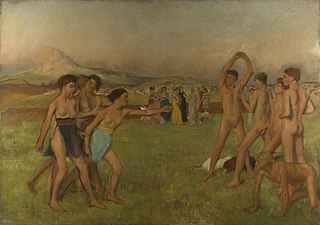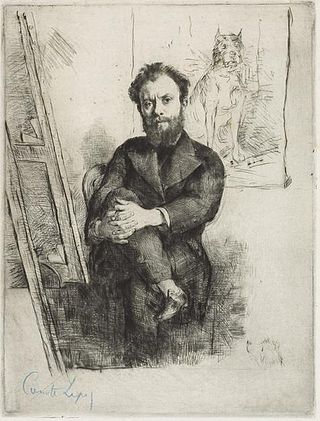
Édouard Manet was a French modernist painter. He was one of the first 19th-century artists to paint modern life, as well as a pivotal figure in the transition from Realism to Impressionism.

Impressionism was a 19th-century art movement characterized by relatively small, thin, yet visible brush strokes, open composition, emphasis on accurate depiction of light in its changing qualities, ordinary subject matter, unusual visual angles, and inclusion of movement as a crucial element of human perception and experience. Impressionism originated with a group of Paris-based artists whose independent exhibitions brought them to prominence during the 1870s and 1880s.

Mary Stevenson Cassatt was an American painter and printmaker. She was born in Allegheny, Pennsylvania, and lived much of her adult life in France, where she befriended Edgar Degas and exhibited with the Impressionists. Cassatt often created images of the social and private lives of women, with particular emphasis on the intimate bonds between mothers and children.

A pastel is an art medium that consist of powdered pigment and a binder. It can exist in a variety of forms, including a stick, a square, a pebble, or a pan of color, though other forms are possible. The pigments used in pastels are similar to those used to produce some other colored visual arts media, such as oil paints; the binder is of a neutral hue and low saturation. The color effect of pastels is closer to the natural dry pigments than that of any other process.

Edgar Degas was a French Impressionist artist famous for his pastel drawings and oil paintings.

Ronald Brooks Kitaj was an American artist who spent much of his life in England.

Portraits at the Stock Exchange is a painting by the French artist Edgar Degas. Completed in about 1879, the painting was already in the collection of the French banker Ernest May when it was listed in the catalogue of the fourth Impressionist exhibition that year. It may also have been shown in the next Impressionist exhibit in 1880, but it was not well known until it entered the collections of the Louvre in 1923. The canvas shows an interior corner of the open trading floor of the Paris Stock Exchange. May stands in the center of the picture wearing a top hat and pince-nez, listening to his colleague, a certain M. Bolâtre, leaning over his shoulder. They are likely discussing a document, possibly a bordereau, held aloft by a partially obscured third party.

The Art Institute of Chicago, founded in 1879, is one of the oldest and largest art museums in the United States. It is based in the Art Institute of Chicago Building in Chicago's Grant Park. Internationally recognized for its curatorial efforts and popularity among visitors, its collection, stewarded by 11 curatorial departments, is encyclopedic, and includes works such as Georges Seurat's A Sunday on La Grande Jatte, Pablo Picasso's The Old Guitarist, Edward Hopper's Nighthawks, and Grant Wood's American Gothic. Its permanent collection of nearly 300,000 works of art is augmented by more than 30 special exhibitions mounted yearly that illuminate aspects of the collection and present curatorial and scientific research.

The Child's Bath is an 1893 oil painting by American artist Mary Cassatt. The painting continues her interest in depicting bathing and motherhood, but it is distinct in its angle of vision. Both the subject matter and the overhead perspective were inspired by Japanese Woodcut prints and Edgar Degas.

Miss La La at the Cirque Fernando is an oil on canvas painting by the French Impressionist artist Edgar Degas. Painted in 1879 and exhibited at the Fourth Impressionist Exhibition in Paris that same year, it is now in the collection of the National Gallery in London. It is Degas's only circus painting, and Miss La La is the only identifiable person of color in Degas's works. The special identity of Miss La La and the great skills Degas used in painting her performance in the circus made this piece of art important, widely appreciated but, at the same time, controversial.

Young Spartans Exercising, also known as Young Spartans and as Young Spartan Girls Challenging Boys, is an early oil on canvas painting by French impressionist artist Edgar Degas. The work depicts two groups of male and female Spartan youth exercising and challenging each other in some way. The work was purchased by the trustees of the Courtauld fund in 1924 and is now in the permanent collection of the National Gallery in London.

Interior, also known as The Rape, is an oil painting on canvas by Edgar Degas (1834–1917), painted in 1868–1869. Described as "the most puzzling of Degas's major works", it depicts a tense confrontation by lamplight between a man and a partially undressed woman. The theatrical character of the scene has led art historians to seek a literary source for the composition, but none of the sources proposed has met with universal acceptance. Even the painting's title is uncertain; acquaintances of the artist referred to it either as Le Viol or Intérieur, and it was under the latter title that Degas exhibited it for the first time in 1905. The painting is housed in the Philadelphia Museum of Art.

Ludovic-Napoléon Lepic was a French artist, archaeologist and patron of the arts. He was styled as Vicomte Lepic until his father's death in 1875, when he succeeded to the title of Comte Lepic. He is best remembered today as a friend of Edgar Degas, who included him in some eleven paintings and pastels. He was among the original Impressionist group and later became a recognised marine painter.

The M.T. Abraham Foundation is a non-profit cultural institution, which is part of the Israeli M.T. Abraham Group. Its headquarters are in Tel Aviv, Israel, and its part of the collection is on permanent display in Mostar. Its stated intent is to promote public appreciation of the most important styles of Modernism: Post-Impressionism, Fauvism, Cubism, Cubo-Futurism, Futurism, Constructivism and Suprematism by collecting pieces that can be loaned "for the sole purpose of display and study by public institutions," and to present most effectively the first half of the 20th century, a period that saw revolutionary tendencies shape the art scene.

The Dance Lesson is an oil on canvas painting by the French artist Edgar Degas created around 1879. It is currently kept at the National Gallery of Art in Washington, D.C. There is at least one other work by Degas by this title, also made in about 1879, which is a pastel.

Still Life with Profile of Laval is an 1886 oil painting by French artist Paul Gauguin, located in the Indianapolis Museum of Art, which is in Indianapolis, Indiana. It depicts Gauguin's friend Charles Laval in profile with an assortment of inanimate objects, including a ceramic pot Gauguin made himself.

After the Bath, Woman Drying Herself is a pastel drawing by Edgar Degas, made between 1890 and 1895. Since 1959, it has been in the collection of the National Gallery, London. This work is one in a series of pastels and oils that Degas created depicting female nudes. Originally, Degas exhibited his works at Impressionist exhibitions in Paris, where he gained a loyal following.
Carol Armstrong is an American professor, art historian, art critic, and photographer. Armstrong teaches and writes about 19th-century French art, the history of photography, the history and practice of art criticism, feminist theory and women and gender representation in visual culture.

A Woman and a Girl Driving is an oil-on-canvas painting by American Impressionist Mary Cassatt, painted in 1881. It emphasizes the theme of female autonomy in a male dominated society. Lydia Cassatt, the artist's sister, is shown holding the reins of the family's carriage alongside Odile Fèvre, the niece of Edgar Degas, and a servant to the family, Mathieu, traveling through the Bois de Boulogne in Paris. Emphasizing Lydia's position of command, Cassatt draws attention to the evolving perceptions of female identity in the late 19th century. The painting serves to challenge prevailing social norms of the time and unveil the range of female experience.

At the Races in the Countryside or Carriage at the Races is an 1869 oil painting by the French painter Edgar Degas. The painting, which depicts a scene of a family in a horse-drawn carriage in the countryside, is on display at the Museum of Fine Arts Boston. The painting was shown at the First Impressionist Exhibition in 1874.



















